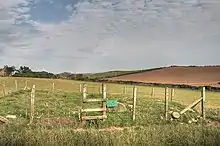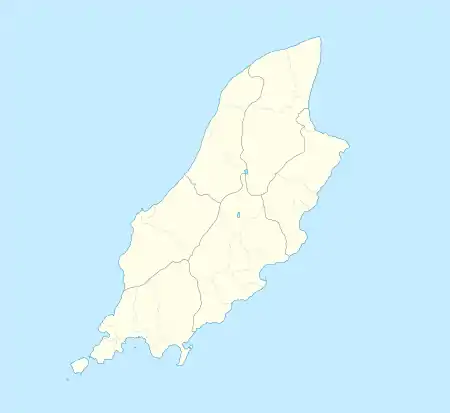Knock y Doonee
Knock y Doonee is a significant historical and archaeological site in the parish of Andreas in north of the Isle of Man. The site has been in ritual use for centuries. Archaeological excavations on the hilltop have uncovered a bilingual ogham stone; a Christian keeill (a small chapel); a Christian carved stone cross; and a Viking Age boat burial.[1]
 The site of the Knock y Doonee ogham stone (now in the Manx Museum) | |
 Map of the Isle of Man showing the location of Knock y Doonee | |
| Location | Knock y Doonee Andreas |
|---|---|
| Region | Isle of Man |
| Coordinates | 54.392916°N 4.458138°W |
| History | |
| Periods | Medieval, Viking |
| Site notes | |
| Public access | Yes |
Archaeological sites
The site was first excavated in 1911 by P. M. C. Kermode. In 1927 Kermode, now director of the Manx Museum,[2] once again investigated the site. It was during this excavation that the Viking Age boat burial and associated grave goods were discovered.
Knock y Doonee Keeill
The remains of an ancient keeill were discovered at this site. A keeill is a small simple chapel built between the 6th and 12th centuries on the Isle of Man.[3] The keeill is thought to be very early, dating possibly to 400–600 AD.[4] Very little of the original keeill remains.
The site was investigated by the Manx Archaeological Survey under P. M. C. Kermode in 1911. The walls were constructed from beach boulders and surface stones, and with an average thickness of 1.1 m. Like many keeills, the structure was small, measuring 9.7 m × 8.2 m internally. The entrance door was located at the west end. Carved socket stones may have been used for a door.[4]
The remains of the altar were found against the east wall on a cobbled floor. The altar was made up of a large slab measuring 0.7 m × 0.4 m × 0.05 m which balanced on two side slabs.[5] The altar was relatively low, standing at only 0.6 m in height. Kermode suggested that a portable altar may have been placed on top of the slab.[4] Over 100 white quartz pebbles were discovered around the altar, which were possibly votive or prayer offerings.[5]
Ogham Stone
A bilingual early Medieval memorial stone was discovered at this site. The inscription in Latin reads Ammecati filius Rocati hic iacit ("Ammecatos son of Roactus lies here").[1] However the Ogham inscription cannot be read with certainty as it has been badly damaged. It is currently housed in the Manx Museum.
Stone cross slab
A broken boulder with a carved cross on it was excavated in 1911 by the Manx Archaeological Survey.[6] It is a plain cross with open ends that are connected by a ring.
Viking ship burial
In autumn 1927 P. M. C. Kermode excavated a large grass covered burial mound. A Viking ship burial dating to 900–950 AD was discovered.[1] Although almost all of the timber from the original vessel has long rotten away, some 300 iron rivets were still in place, and their position showed that the boat was between 8.5-9 m long and 1.8-2.4 m wide.[7]
A Viking man was buried there. He was wrapped in a cloak and was accompanied by many grave goods. He was buried with several domestic items such as fishing gear, a cloak-pin, and a bowl.[1] The smith's hammer, tongs and nails that were buried with him may indicate that he was a blacksmith.[8] Additionally, a sword, shield, axe and a spear were uncovered.[9] The remains of a horse and a dog also were found to accompany the burial. The man was most likely a prominent member of his community due to the quality of his grave goods and the elaborate burial that was given to him.[10]
Although the burial was certainly pagan,[1] it was within close sight of the nearby keeill. There were also no human sacrifices, which was present at the older Balladoole Viking boat burial.[11] These factors may be a sign that there was a gradual move away from traditional Viking beliefs and practices during this period.[4]
References
- Kermode, P. M. C (15 December 1927). "Knoc y Doonee". Isle of Man Natural History and Antiquarian Society. 3: 241–249.
- "Philip Moore Callow Kermode, 1855-1932". A Manx Notebook. Retrieved 6 December 2020.
- Lowe, Christopher Edmund (1988). Early Ecclesiastical Sites in the Northern Isles and Isle of Man: An Archaeological Field Survey (PDF) (PhD thesis). University of Durham. p. 3.
- "Keeills and Cake; Knock-e-Dhooney, Andreas". Manx Keeills. 26 May 2016. Retrieved 6 December 2020.
- "Knock y Doonee Keeill". iMuseum. Retrieved 6 December 2020.
- "Knock y Doonee Cross Slab". iMuseum. Retrieved 6 December 2020.
- Adams, Max (2017). Ælfred's Britain: War and Peace in the Viking Age. London: Head of Zeus. ISBN 1-78408-030-6. OCLC 987328989.
- "Vikings in Mann" (PDF). Manx National Heritage. 2003. Retrieved 6 December 2020.
- "Knock e Dooney Ship Burial". iMuseum. Retrieved 6 December 2020.
- Gardeła, Leszek; Larrington, Carolyne, eds. (2014). "Viking Myths and Rituals on the Isle of Man" (PDF). Languages, Myths and Finds. 1: 32.
- Shane, McLeod (2018). "Human Sacrifice in Viking Age Britain and Ireland". Australian Early Medieval Association: 76.
External links
- Interactive 3D model of Knock y Doonee stone cross slab
- Interactive 3D model of Knock y Doonee ogham Stone